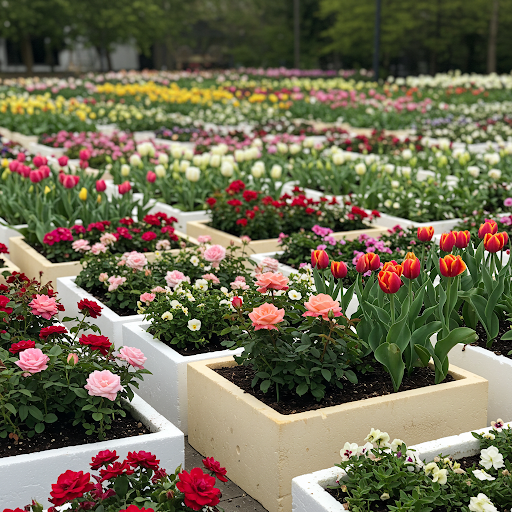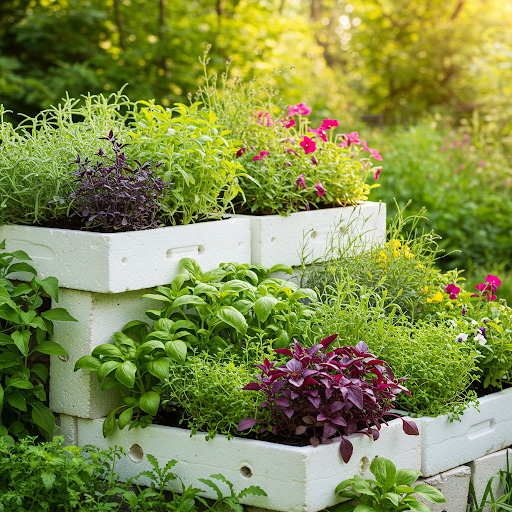Beginner Gardener? You Won’t Believe How Easy It Is to Grow Anything in These Simple Boxes!
Starting your own garden can feel overwhelming, but it doesn’t have to be complicated or expensive. The Spanish article you shared from trucoshogarjardin.com points to a fantastic solution for beginners looking to grow flowers, vegetables, and herbs with ease: styrofoam boxes. These often-discarded containers can be transformed into surprisingly effective and beginner-friendly gardening vessels. Let’s explore why styrofoam boxes are a great choice for new gardeners in the US.

Why Styrofoam Boxes Are a Beginner Gardener’s Best Friend:
Styrofoam boxes, often used for shipping produce or other goods, offer a range of advantages that make them ideal for those just starting their gardening journey:
- Lightweight and Easy to Move: Unlike heavy clay or concrete pots, styrofoam boxes are incredibly light, making them easy to move around your patio, balcony, or garden as needed to follow the sun or protect plants from harsh weather.
- Excellent Insulation: Styrofoam provides good insulation, which can help protect plant roots from extreme temperature fluctuations, keeping them cooler in the summer and warmer in the early spring or late fall.
- Good Drainage (with a little help): While they don’t come with drainage holes, it’s very easy to add them, which is crucial for healthy plant growth.
- Affordable and Often Free: You can often find styrofoam boxes for free at grocery stores, fish markets, or other retailers who receive shipments in them. This makes gardening accessible even on a tight budget.
- Versatile for Various Plants: From colorful flowers and flavorful herbs to a surprising range of vegetables, many plants thrive in styrofoam containers.
- Upcycling and Eco-Friendly: Reusing styrofoam boxes is a great way to reduce waste and give these materials a new purpose.
Getting Started: Your Beginner’s Guide to Styrofoam Box Gardening:
- Source Your Boxes: Visit local grocery stores, farmers’ markets, fishmongers, or even online marketplaces to find clean and sturdy styrofoam boxes. Different sizes will suit different plants. Deeper boxes are better for root vegetables and larger plants.
- Create Drainage: This is the most important step! Use a drill, screwdriver, or even a sharp stick to create several drainage holes in the bottom of each box. Aim for at least 4-5 holes for a standard-sized box to prevent waterlogging.
- Choose Your Location: Select a spot that receives the appropriate amount of sunlight for the plants you intend to grow. Most vegetables and flowering plants need at least 6-8 hours of sunlight per day.
- Select Your Plants: Consider what you’d like to grow. Many beginners find success with:
- Vegetables: Lettuce, spinach, kale, radishes, carrots (in deeper boxes), herbs, peppers, tomatoes (in larger boxes).
- Flowers: Marigolds, petunias, impatiens, zinnias, and many other annuals.
- Herbs: Basil, mint, parsley, cilantro, chives.
- Fill with the Right Soil: Never use garden soil directly in containers, as it can compact and drain poorly. Instead, use a good quality potting mix specifically formulated for containers. You can also amend it with compost for added nutrients.
- Plant Your Seeds or Seedlings: Follow the instructions on your seed packets or plant tags for proper spacing and planting depth.
- Water Wisely: Container gardens tend to dry out faster than in-ground gardens. Water your plants when the top inch of soil feels dry to the touch. Ensure excess water can drain out through the holes you created.
- Fertilize Regularly: As plants grow in containers, they use up the nutrients in the potting mix. Use a balanced liquid fertilizer or slow-release granular fertilizer according to the product instructions.

Tips for Success with Styrofoam Box Gardening:
- Elevate Your Boxes: Placing your styrofoam boxes on bricks or pot feet can improve drainage and airflow.
- Consider the Color: Dark-colored boxes can absorb more heat. In very hot climates, you might consider painting them a lighter color or placing them in a slightly shadier spot.
- Reinforce if Needed: For very large plants or if you plan to move the boxes frequently, you can reinforce the sides with duct tape for added stability.
- Safety First: While generally considered safe for gardening, some people have concerns about chemicals leaching from styrofoam. Using a good quality potting mix as a barrier between the styrofoam and the plant roots can help mitigate any potential risks. Avoid using styrofoam boxes that were used to store harsh chemicals.
Conclusion:
Gardening in styrofoam boxes offers a simple, affordable, and effective way for beginners to get their hands dirty and enjoy the rewards of growing their own plants. With their lightweight design, insulation benefits, and easy customization, these humble containers can become the foundation for a thriving and beautiful garden, no matter your experience level. So, start collecting those styrofoam boxes and get ready to experience the joy of gardening!
11V
By greenship|2024-08-13T03:05:48+00:00August 13, 2024|Categories: Hand-carving Series|
KC3-14A
By greenship|2024-08-16T06:26:30+00:00August 16, 2024|Categories: Hand-carving Series|
20T
By greenship|2024-08-13T06:42:22+00:00August 13, 2024|Categories: Hand-carving Series|
KC2-11V
By greenship|2024-08-16T05:39:50+00:00August 16, 2024|Categories: Hand-carving Series|
20VD
By greenship|2024-08-13T06:43:41+00:00August 13, 2024|Categories: Hand-carving Series|
Modern Plant Pots丨Planter for Indoor Plants,8 inch or 10 inch Plant Pots with Drainage Hole,Decorative Flower Pots
By greenship-seo|2025-04-10T08:32:55+00:00January 7, 2025|Categories: Hand-carving Series|Tags: Decorative Flower Pots, Self-Watering Pots|






